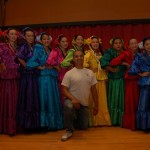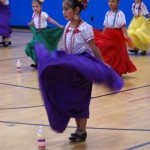Ballet Folklorico at Laurel Dell

The multi-part program in Ballet Folklorico was inaugurated with an assembly performances by the Ballet Folklorico Netzahualcoyotl at Laurel Dell, and Ensembles Ballet Folklorico at Hamilton. The troupes performed dances from several regions of Mexico including La Danza de Los Viejitos, which is an allegory for respecting your elders, and Las Amarillas, which shows the beautiful movement of birds. Students learned about each dance and joined along in movements and song!


Kindergarten: Maria Cirila, About a girl who makes Chocolate
1st Grade: La Guacamaya, about the Macaw bird
2nd and 3rd Grades: La Iguana, Mimicking the movements of the Iguana
4th Grade: El Colas, About a popular boy named Nicolas
5th Grade: La Bamba, The traditional version of the popular song.
The teachers at Laurel Dell also received professional development sessions with Mentor Artist Nydia Gonzalez in which they learned the historical and cultural context of the dances; dance steps; and, how to sing and play instruments to accompany the student performers. This enabled teachers to continue practice when the artist was not there, as well as further integrate the content into academic lessons.

Each of the students took part in making their own costumes by creating
Students learned to breathe deep, and stretch and strengthen their muscles through some Yoga techniques. A few children commented to Maestro Zenon that they liked learning how to stretch and breathe. One student said that he felt like his heart beat better afterwards. Through dance techniques and floor exercises, students learned to follow choreography creating squares, circles and triangles as a group, and how to move within the limits of the stage space. They also learned how to create the intricate percussive rhythms with their feet, which play a large part in the Folkloric dances of Mexico.
Students at both schools (and some of their teachers!) performed their dance at their school-wide Fiestas, where students were able to compare and contrast the stories, styles, and music of each dance performed, and community members enjoyed the colors and sounds of their festive dances!
